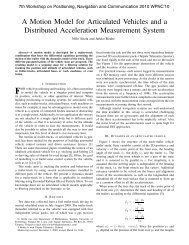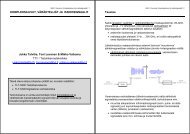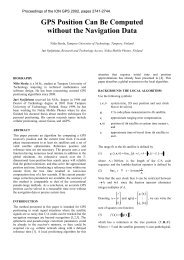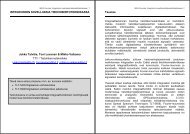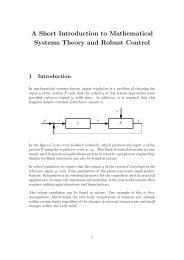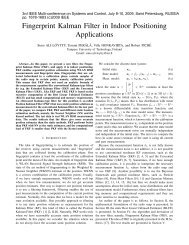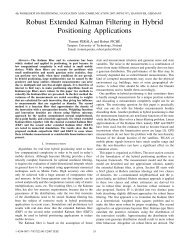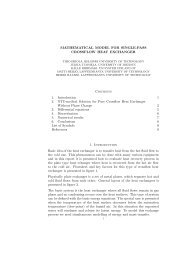Antti Lehtinen Doppler Positioning with GPS - Matematiikan laitos
Antti Lehtinen Doppler Positioning with GPS - Matematiikan laitos
Antti Lehtinen Doppler Positioning with GPS - Matematiikan laitos
You also want an ePaper? Increase the reach of your titles
YUMPU automatically turns print PDFs into web optimized ePapers that Google loves.
the Transit, the receiver was lucky to be able to track even one satellite. Most of<br />
the time there were no satellites in the view. On the contrary, there are usually<br />
several <strong>GPS</strong> satellites in the view at the same time. Even if the receiver is indoors,<br />
most of the <strong>GPS</strong> signals can be received, although attenuated. The high number<br />
of satellites allows a <strong>GPS</strong> receiver to have simultaneous <strong>Doppler</strong> measurements<br />
from several satellites. This is a huge increase in the amount of information that<br />
can be used for the positioning.<br />
In addition, the <strong>GPS</strong> frequency is much higher than the Transit frequencies.<br />
This is a benefit, because relative frequency measurement errors become smaller.<br />
Furthermore, the higher frequency causes smaller atmospheric errors. As a conclusion,<br />
it cannot be said which is better: the Transit or the <strong>GPS</strong> <strong>Doppler</strong> positioning.<br />
Both have their advantages and drawbacks. A summary of these is<br />
shown in Table 4.1. After all, one can say that the <strong>GPS</strong> <strong>Doppler</strong> positioning<br />
may well be of at least the same accuracy as the Transit. Thus, there is a reason<br />
for further <strong>GPS</strong> <strong>Doppler</strong> positioningresearch. More thorough positioningerror<br />
analysis will be provided in Chapter 5.<br />
Table 4.1: Comparison between <strong>GPS</strong> <strong>Doppler</strong> positioningand Transit<br />
<strong>GPS</strong> Transit<br />
+Better satellite availability +Two different frequencies<br />
+Higher frequency +Higher satellite velocities<br />
+Lower satellite orbits<br />
4.3 The Governing Equations<br />
Let us now begin to build a physical model for the <strong>GPS</strong> <strong>Doppler</strong> positioning. This<br />
will eventually lead to an algorithm, that can be used in position estimation.<br />
4.3.1 The <strong>Doppler</strong> Shift Equation<br />
The frequency of the received <strong>GPS</strong> signal differs from the frequency transmitted<br />
by the satellite. This easily measurable frequency offset is mainly due to the<br />
<strong>Doppler</strong> effect. The <strong>Doppler</strong> effect is caused by the relative motion of the transmittingsatellite<br />
<strong>with</strong> respect to the receiver. The <strong>Doppler</strong> Shift can be modelled<br />
<strong>with</strong> the dot product equation<br />
<br />
wi − wu<br />
Di = − •<br />
c<br />
ri<br />
<br />
− ru<br />
L1<br />
(4.1)<br />
ri − ru<br />
18




